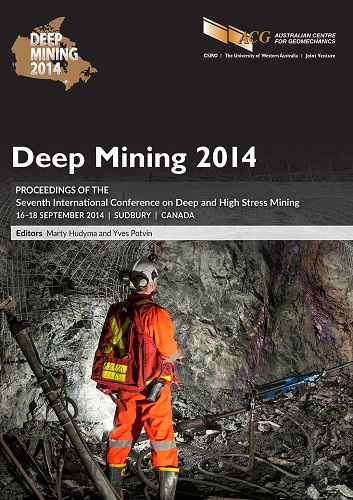Shear rupture – two case studies from a deep mine

|
Authors: Bewick, RP; Kaiser, PK; Bawden, WF |
DOI https://doi.org/10.36487/ACG_rep/1410_45_Bewick
Cite As:
Bewick, RP, Kaiser, PK & Bawden, WF 2014, 'Shear rupture – two case studies from a deep mine', in M Hudyma & Y Potvin (eds), Deep Mining 2014: Proceedings of the Seventh International Conference on Deep and High Stress Mining, Australian Centre for Geomechanics, Perth, pp. 641-658, https://doi.org/10.36487/ACG_rep/1410_45_Bewick
Abstract:
When a fault-slip event mechanism is determined, it is easy to assume that there must be a fault present to generate the event. A pre-existing fault is not needed to create a fault-slip event. Fault rupture (the failure process in brittle rocks which occurs under confined conditions) also generates a fault-slip focal mechanism. Fault ruptures will commonly occur far from mining, in abutments, wide pillars, and sills. First the rupture process is overviewed. Then two mining fault rupture case examples are summarised to show the fault rupture process, final rupture geometry, and energy release potential observed in the field conform to theoretical understanding. In this article it is shown that the fault rupture process and energy release depends on the boundary condition (system stiffness) surrounding the failure process. While seemingly theoretical, the findings have practical significance with respect to rock mass characterisation, microseismic monitoring, rock mass behaviour back analysis, and mining strategy.
References:
Bewick, RP 2013, ‘Shear rupture of massive brittle rock under constant normal stress and stiffness boundary conditions’, PhD thesis, University of Toronto, Toronto.
Bewick, RP, Kaiser, PK, Bawden, WF & Bahrani, N 2013a, ‘DEM simulation of direct shear: 1. Rupture under constant normal stress boundary conditions’, Rock Mechanics and Rock Engineering,
Bewick, RP, Kaiser, PK, Bawden, WF 2013b, ‘DEM simulation of direct shear: 2. Grain boundary and mineral grain strength component influence on shear rupture’, Rock Mechanics and Rock Engineering,
Bewick, RP, Kaiser, PK, Bawden, WF 2013c, ‘Shear rupture under constant normal stiffness boundary conditions’, Tectonophysics,
Coulson, AL 2009, ‘Investigation of the pre to post peak strength and behaviour of confined rock masses using mine induced microseismicity’. PhD thesis, University of Toronto, Toronto.
Hallbauer, DK, Wagner, H & Cook, NGW 1973, ‘Some observations concerning the microscopic and mechanical behaviour of quartzite in stiu triaxial compression tests’, International Journal of Rock Mechanics and Mining Sciences & Geomechanics Abstracts 10, pp. 713-726.
Hyett, AJ, Bawden, WF, Lausch, P, Moosavi, M, Ruest, M & Pahkala, M 1997, ‘The S.M.A.R.T. cable bolt: an instrument for the determination of tension in 7-wire strand cable bolts’, in In E Broch, A Myrvang & G Stjern (eds), Proceedings of the International Symposium on Rock Support – Applied Solutions for Underground Structure, Helli Grafisk, Oslo, pp. 25-40.
Lajtai, EZ 1969, ‘Mechanics of second order faults and tension gashes’, Geological Society of America Bulletin, vol. 80, no. 11, pp. 2253-2272.
Lockner, DA, Byerlee, JD, Kuksenko, V, Ponomarev, A & Sidorin, A 1991, ‘Quasi-static fault growth and shear fracture energy in granite’, Nature, vol. 350, pp. 39-42.
Morgenstern, NR, Tchalenko, JS 1967, ‘Microscopic structures in kaolin subjected to direct shear’, Geotechnique, vol. 17, no. 4, pp. 309-328.
Scholz, CH 1968, ‘Microfracturing and the inelastic deformation of rock in compression’, Journal of Geophysical Research, vol. 73, no. 4, pp. 1417-1432.
Trifu, CI & Urbacic, TI 1996, ‘Fracture coalescence as a mechanism for earthquakes: observations based on mining induced microseismicity’, Tectonophysics, vol. 261, pp. 193-207.
Wiles, TD 2011, Map3D: Mine Analysis Package in Three Dimensions, version V58, Mine Modelling Pty Ltd, Mt.Eliza,
© Copyright 2025, Australian Centre for Geomechanics (ACG), The University of Western Australia. All rights reserved.
View copyright/legal information
Please direct any queries or error reports to repository-acg@uwa.edu.au
View copyright/legal information
Please direct any queries or error reports to repository-acg@uwa.edu.au